When it comes to iOS app development, two prominent technologies appear on the frontline-Flutter and Swift. While Futter is a cross-platform development framework, Swift is a programming language for native app development. Both technologies are different yet they hold great dominance in the iOS development field.
And since they both serve the same niche, the battle is obvious. There is a constant rivalry between Flutter vs Swift in the market. Many developers and business owners are often confused about choosing the best between them for their iOS app project.
However, selecting the best one in Flutter vs Swift is genuinely not an easy decision to make. It is because they both offer plenty of features & tools. And which of them is suitable for your project particularly, that is a great challenge to figure out.
To help you with this, we will give you a detailed comparison between Flutter and Swift. By the end of this blog, you will know which one is better for your iOS app development project.
Table of Contents
Why There Is a Need for Comparison Between Flutter Vs Swift?
Flutter and Swift are popular technologies in the iOS development realm. Both tools come with different development approaches but cater to the same goal. However, there is a big difference between them. Flutter is a cross-platform framework or SDK.
It allows the creation of apps for iOS and Android using natively compiled UIs and ready-to-use components and widgets. Flutter has a good size of the developer community. As per StackOverflow Developer Survey 2022, Flutter is among the top technologies for creating apps with 13.55% share in the market.
Whereas, Swift is technically a programming language used in native iOS application development. It provides support for creating iOS apps only using Apple’s own SDK tools.
As iOS market share is growing significantly due to its increasing user base and market penetration. The future of iOS app development seems more open and wider than ever. Today, businesses and developers have multiple options for building iOS apps. They can use cross-platform development frameworks like Flutter, and native SDKs like Swift & Xcode.
But Flutter and Swift demand different approaches. Determining which one of them suits better to a particular app project is complex. It is because Flutter uses a cross-platform development approach, dart programming language, and natively compiled UIs. Swift, on the other hand, utilizes Apple’s native SDK resources.
These differences not only affect the iOS app development cost but also the quality and other aspects of the final product. Therefore, it is important to understand the difference between them and have a detailed insight into the comparison of Flutter vs Swift.
What is Flutter?
Flutter is a cross-platform app development framework owned by Google. It is an open-source mobile app development technology that allows developers to write a single codebase for all mobile OS platforms. Flutter has a rich collection of widgets and natively compiled user interfaces for Android, iOS, and other mobile operating systems. It uses Dart as its programming language for creating apps for iOS and Android.
Key Features of Flutter
Flutter is a modern UI SDK that comes with innovative features allowing developers to build compelling apps. Its architecture is built with three layers-embedder, engineer, and framework, which makes it an efficient technology. Here are the features of Flutter that make it a reliable choice for developing iOS apps.
1. Cross-Platform Development
Flutter provides high-standard cross-platform application development support. It allows developers to write a single codebase and deploy it across all platforms desktop, mobile, and web. There is no need for creating apps separately for each device platform.
By simply writing once, you can launch your app on various platforms. Moreover, Flutter also helps in updating and adding new features to your app easily. Developers can make changes to the code once. Hence, it saves significant time and cost.
2. Hot Reload Feature for Faster App Development
Hot reload is a unique feature of the Flutter framework. This feature helps in improving the development speed and the developer’s productivity. With Hot Reload. Developers can view the changes done in the code in real-time. They can view the changes side by side on their screen with a sub-second delay. And thus, detect any potential effort before it happens in the application.
3. Customizable UI Design
Flutter is known for offering a rich UI library and extended support for customizing UI design. It even allows easy customization for complex UI designs which are sometimes not feasible with native development frameworks. Designers can get shadow manipulations, color, shape, and shared element transitions in Flutter for designing applications. Consequently, it makes the UI design process more flexible without increasing the workload.
4. An Extensive Number of Widgets
Flutter SDK has a variety of widgets. These widgets are used to build a mobile app’s fundamental building blocks and visual components. The best thing about Flutter’s widgets is they are designed to meet the latest guidelines of Android’s Material Design and Apple’s Cupertino Style. Using these widgets, developers can effortlessly customize the user interfaces.
5. Accessibility to Native Features
Creating native apps is expensive. Businesses can’t afford to build native apps repeatedly. Here, Flutter provides great resources and natively-compiled Uis which assist in creating native-like apps. Mobile apps built with Flutter give the same performance as native ones.
It is due to Flutter’s non-dependency over intermediate code representations. Flutter app development is executed directly into machine code. Thus, it eliminates any potential bugs or errors related to the interpretation process.
What is Swift?
Swift is a general-purpose and open-source programming language for iOS development. It is Apple’s own language which is used as part of native iOS SDK for iOS, iPad, macOS, watchOS, and tvOS. Swift is an upgraded version of Objective-C that offers better ease of use, simplicity, and good maintainability. At present, Swift has over 4.2M developers who use it as the default language for creating iOS apps. Source
This is beacuse swift contains all the features that a modern programming language should have. Its coding comes with enhanced readability, clear syntax, and improved safety. Therefore, it is counted among the top iOS app development languages in 2023.
Key Features of Swift
Swift comes with improved capabilities that help in developing iOS apps more efficiently. It is relatively new and offers great support due to the following features:
1. Interoperability
Although Swift is the latest programming language version it is still quite compatible with Objective-C. It means iOS developers can work along with Objective-C as well. Swift’s interoperability makes it easier for developers to integrate this language with other platforms and tools.
2. Easier Programming
Swif’s programming syntax is precise and expressive. It requires less code writing as compared to other languages. Consequently, developers don’t have to put huge manual efforts into tracking and managing memory. Swift has automatic reference counting (ARC) which automates various tasks in programming.
3. Enhanced Performance
Apple released Swift with the goal to improve the speed and performance of iOS development. Swift performs much better than Objective-C and optimizes the development process through its protocol-oriented programming. SwiftUI for iOS app development contains all the additional features as well. As a result, it improves the speed and efficiency of the development process.
4. Extended Development Support
Swift is primarily built for native iOS app development. However, it can be used for developing apps for Linux, Windows, and Ubuntu including Apple’s entire family devices. Swift is an open-source technology so developers can freely use it across the globe.
Flutter vs Swift: Side-by-Side Comparison
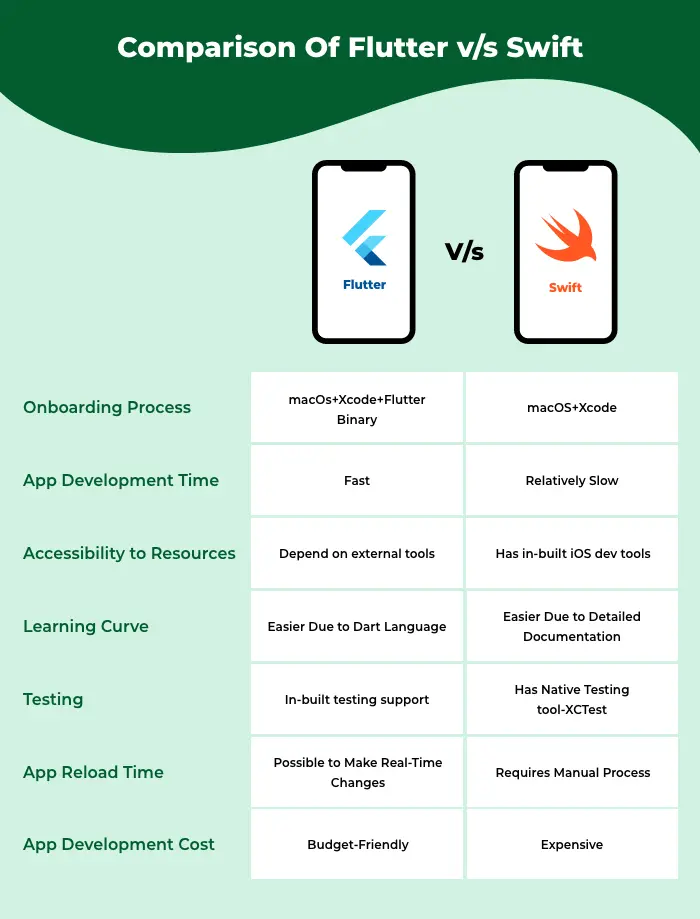
1. Onboarding Process
The onboarding process means how developers are familiar with the new interface and functionality of the tool. When you hire an iOS app developer you need to ensure the developer can smoothly adjust to the development tool. So when it comes to getting started with iOS app development with Flutter, it requires a dedicated process. Developers need to go through a detailed ‘getting started document for macOS. They have to use Xcode and the Flutter binary.
Swift is used as part of native app development. So developers have to use Xcode as the IDE along with a macOS device to use Swift as the programming language. Once you install Xcode on the macOS device, you can start a new iOS project in Xcode by following the below step
File>New>Project>iOS>Single View App.
Here, Xcode makes the iOS template code. Developers can smoothly start developing iOS apps.
So, on comparing Flutter vs Swift in terms of the onboarding process, the winner is- Swift
2. App Development Time
Flutter allows you to run a command on Flutter to check the development time for the project. Usually, Flutter has a slower speed in iOS development than Swift. It is because Flutter lacks behind in giving developers clean builds which helps in creating apps much faster.
Swift, on the other hand, provides a cleaner build than Flutter. Xcode provides temple code which enables developers to write code much faster. As a result, Swift helps in delivering faster iOS app development services.
Apparently, Swift is the clear winner in this comparison parameter of Flutter vs Swift.
3. Accessibility to Resources
For developing apps, a developer might need various tools & additional resources. The more resources a technology has to offer, the wider accessibility it has. Flutter is after all a third-party iOS development technology. It depends on external sources for integrating additional features into the app. Flutter lacks internal support and tools for allowing the creation of advanced-scale iOS apps.
On the contrary, Swift comes with wide in-built capabilities and tools. It utilizes iOS native UI SDK which is much faster and easier to integrate with iOS apps. Apple offers various tech stacks for creating a variety of innovative features like wearable, AR, IoT, and more. And all these tech stacks can be smoothly implemented with Xcode and Swift.
Hence, in this context, Swift stands out as the winner.
4. Learning Curve
The learning curve of iOS development technology shows how difficult it is to code and create apps. If a tool has an easy learning curve, it will increase the development speed as developers can smoothly work with it. Here, Flutter stands out better than popular frameworks in terms of learning curves. It provides rich documentation support and a comprehensive guide to iOS app development.
Swift is a native programming language of iOS. It comes with improved capabilities than Apple’s previous programming language Objective-C. So developers don’t find any sort of difficulty while coding with Swift. In addition to this, swift was launched in 2014. So it offers rich support for iOS development. Developers need fewer tools as compared to Flutter when creating iOS apps.
Thus, in this Flutter vs Swift case too, Swift stands out as the winner.
5. Testing
For app testing, Flutter has a robust testing framework. It allows developers to write cleaner coders starting from the initial development phase. It has additional testing features for conducting all the required tests like performance and unit testing.
Swift gets the advantage of being a native language. When using Swift, developers get access to Apple’s native testing tool called XCTest. With this tool, they can perform multiple tests and ensure the app is free from all kinds of bugs or technical flaws.
On comparing Flutter vs Swift in terms of testing, both win. So in this criteria, there is a tie.
6. App Reload Time
Flutter has a prominent feature popularly known as Hot Reload. This feature enables developers to make changes to the code and review it in real time. Flutter developers can easily check the changes made in a few seconds. As a result, it assists in speeding up the development process.
In iOS native development, app loading time is slower than in Flutter. It requires considerable time and process to make changes. iOS developers have to put in manual effort to ensure the simulator displays the changes made to the code.
Hence, it is evident to see Flutter defeats Swift in this aspect.
7. App Development Cost
Cost is the most important consideration that most business owners take care of. Generally, developing iOS apps requires a considerable budget. For startups and entrepreneurs, it is not affordable for them to create apps multiple times and spend huge amounts on maintaining apps.
Flutter here takes advantage of being a cross-platform development framework. It uses a single codebase for creating apps for iOS, Android, and other platforms. Plus, businesses don’t have to spend a lot of budgets to hire Flutter app developers.
Developing iOS apps with Swift is relatively quite expensive. It allows developers to only use native IDE and Apple’s own resources. Moreover, since Swift is built for a native development approach, business owners can’t deploy the same app for other OS platforms. They have to create a new app if they wish to launch it for other platforms like Android. Thus, it increases the cost of iOS app development.
Hence, it is clear to see Flutter stands out as the winner when it comes to the cost of app development. Now. Let us see the whole picture of Flutter vs Swift by comparing them in other aspects.
Flutter vs Swift: Comparison Table
|
Criteria |
Flutter | Swift |
|
Popularity (GitHub Stars) |
116K | 55.4K |
|
Community Size |
16.5K |
8.9K |
|
Release Year |
2017 |
2014 |
|
Built by |
Apple |
|
|
Onboarding Process |
macOs+Xcode+Flutter Binary |
macOS+Xcode |
|
Development Time |
Fast |
Relatively Slow |
|
App Reload Time |
Possible to Make Real-Time Changes |
Requires Manual Process |
|
Accessibility |
Depend on external tools |
Has in-built iOS dev tools |
|
Testing |
In-built testing support |
Has Native Testing tool-XCTest |
|
Learning Curve |
Easier Due to Dart Language |
Easier Due to Detailed Documentation |
|
Open Source |
Yes |
Yes |
|
Cross Platform Compatibility |
Yes |
No |
|
UI Builders |
Flutter UI SDK |
Swift UI |
|
IDE Used |
Visual Code, Android Studio, IntelliJ |
Xcode |
|
Application Size |
Large |
Flexible |
| Cost | Budget-Friendly |
Expensive |
Conclusion: Which Is Better Between Flutter vs Swift?
When comparing Flutter and Swift on various parameters, it seems Swift stands out better than Flutter. However, it is important to note that we are comparing two different technologies. Flutter is a cross-platform development framework. Whereas, Swift is a native programming language.
Therefore, it won’t be justice to declare a winner between Flutter vs Swift. But certainly, both technologies are beneficial and which one serves the best totally depends on your project requirements.
If you are running on a limited budget and want to launch your iOS app for multiple platforms at the same cost, then Flutter is the best choice in this case. And if your primary target is only iOS users and want to build an app exclusively for the iOS platform, then Swift is a better option.
Hence, here, you have to analyze your needs and choose the better option accordingly.
The best way would be to take assistance from experts who can help in evaluating your iOS app project and make the right selection. And RipenApps is a leading iOS app development company that specializes in creating top-quality iOS apps using Flutter and Swift. Our team is equipped with certified developers who hold excellent skills in utilizing cross-platform frameworks like Flutter and native tools Swift as well.
Schedule a Free Consultation and Speak Directly with our experts
FAQs
Q1. What is the cost to build an iOS app with Flutter?
The cost of iOS application development with Flutter depends on several key factors like the size of the app, number of features, number of API integrations, and so on. Hence, it is advisable to get a quote for the iOS app project from a Flutter development company.
Q2. Which is the better tool for developing apps between Flutter and Swift?
Flutter and Swift are different types of technologies for app development. Which tool is best could be determined based on what type of application you want to build. If cross-platform and low development budget is your concern, then Flutter is good. And if you exclusively want to build an app for iOS, then Swift is better.
Q3. Which are the top companies that have used Flutter?
There are many leading brands that have used Flutter in their applications such as BMW, Alibaba Group, Google Play, CrowdSource, Dream11, and more.
Q4. Which is easier to learn Flutter or Swift?
Swift has a slight edge over Flutter when it comes to learning the programming language. Swift uses an improved version of Objective-C which is quite easy to use and comes with clear coding syntax. Flutter is also easy to learn with Dart. But since Dart is a relatively new language so it might take some time for adoption.


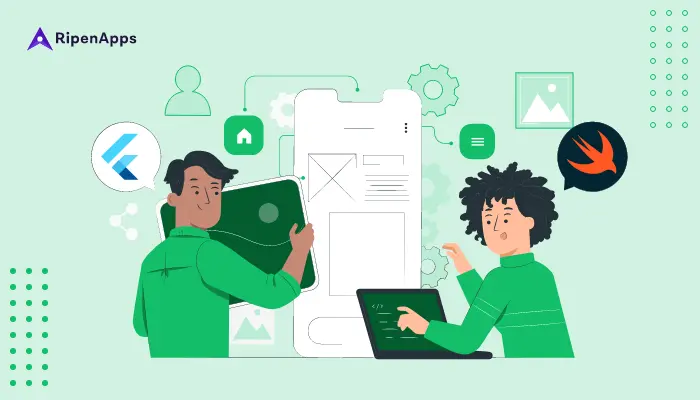




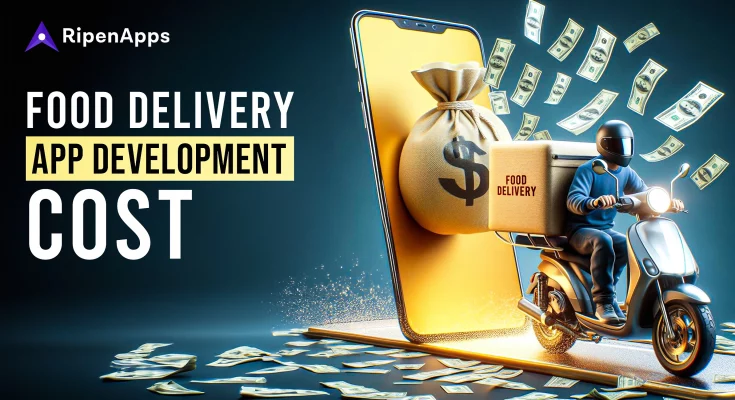
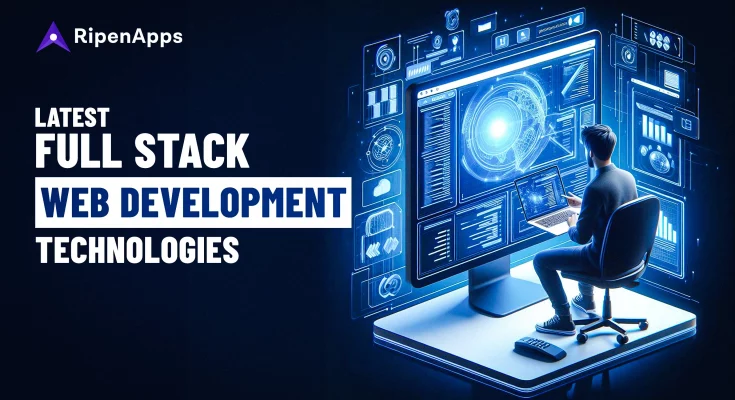
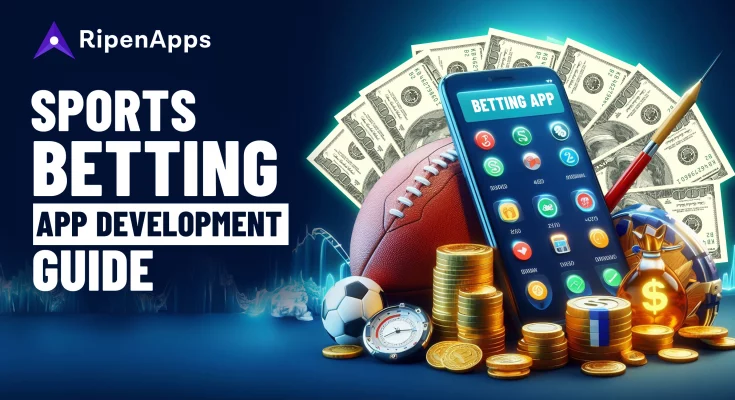
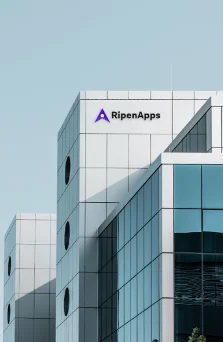
 India
India USA
USA Australia
Australia Canada
Canada UK
UK UAE
UAE